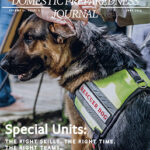U.S. efforts to protect the homeland rapidly changed after September 11, 2001. Although some may have considered the possibility of terrorists using a commercial airplane as a weapon or the mail being a convenient carrier of a biological agent, the successful execution of such events was beyond most people’s comprehension. The 9/11 and Amerithrax attacks in 2001 forced the preparedness and response communities to collectively consider and prepare for low-probability, high-consequence events – including remote and previously inconceivable threats. After those attacks, funding was available to assess, analyze, and exercise the effects these threats would create.
Low Probabilities, But High Consequences
With much time between 2001 and 2014, the response structures have evolved and the funding scenarios have changed. The limited economic environment at all levels of government presents new challenges for maintaining critical infrastructures. Currently, there is a need to examine the low-probability versus high-consequence ratio carefully and allocate restricted dollars responsibly. In the Food and Agriculture sector, a multitude of factors complicates this task; food comes from a complex system of systems with challenges presented through global production and rapid transport.
What makes up an average evening meal has likely traveled hundreds if not thousands of miles before it appears on the kitchen table. The global movement of food products has greatly increased both the quantity and diversity of what is available on grocery store shelves. Unfortunately, this also increases the threats to the nation’s food supply from intentional adulteration. Although people can choose to not fly or to live great distances from a nuclear power plant, they cannot opt out of eating because food is necessary for survival.
There is evidence of “bad actors,” with varied motivations, adulterating food. Authorities have uncovered plots to use food as a delivery mechanism for weapons of mass destruction and, unfortunately, have had food system adulteration as the result of terrorism. Those who alter food products for economic gain – referred to as “economically motivated adulteration” – pose a significant threat. Although not trying to do harm to the health of humans and animals, economically motivated adulterators have created significant public health concerns – for example, adulteration using melamine. Threats from both terrorism and economically motivated adulteration illuminate the need for the preparedness and response communities to stay ever vigilant in protecting the food supply and rapidly responding to system disruptions.
Proposed Rule & Whole Community Approach
The preparedness community – including first responders, law enforcement, medical and public health professionals, emergency planners, government officials, and private sector professionals – has a role in the defense of the food system. Although the infrastructures in place readily handle traditional food safety events, preparing for and responding to an intentional food contamination require the expertise and experience of the whole community. Since 2001, many accomplishments and communities are becoming more interdisciplinary in nature. Although planners, responders, and receivers are actively working to close identified gaps, work remains.
In December 2013, the U.S. Food and Drug Administration (FDA) released a proposed rule establishing requirements for domestic and foreign food facilities to protect the food supply from intentional contamination. This proposed rule partially fills a gap in policy and guidance regarding specific intentional threats to the food system.
The FDA’s Focused Mitigation Strategies to Protect Against Intentional Adulteration is the sixth rule that has been proposed under the Food Safety Modernization Act. Once finalized, the rule will require food facilities to have, among other things, a food defense plan that addresses vulnerabilities in the food operation. Using a risk-based approach, the FDA’s proposed rule targets processes that are most vulnerable to attack – including bulk liquid receiving and loading, liquid storage and handling, secondary ingredient handling (where ingredients other than the primary ingredient of the food are handled before being combined with the primary ingredient), and mixing and similar activities.
The FDA noted that this rule and efforts to protect against intentional adulteration require a shift in perspective from traditional food safety. As with other threats, those intending to cause harm or create economic gain through food adulteration evade standard detection systems. Recognizing that this rule is filling a previously unmet gap in regulation to prevent intentional contamination, the FDA seeks public comment on the proposed rule.
The Preparedness Community’s Call to Action
The preparedness community has unquantifiable hours of experience in protecting the homeland. For example, emergency planners have been involved in writing plans, conducting risk assessments, implementing preventive controls, as well as training and exercising catastrophic scenarios. Planners can share their expertise to help improve food system defense by:
- Reviewing and providing comments on the FDA’s proposed rule to mitigate the intentional adulteration of the food supply. Comments to the FDA are due by 31 March 2014. The proposed rule and instructions for commenting are in the Federal Register.
- Determining how their communities would respond to an intentional attack on the food system: what their roles would be; what, if any, preparedness plans are in place for an intentional food event in their communities; how the food industry will be integrated to support detection and aid response to intentional food contamination.
The food system is an infrastructure that no nation can ignore. As communities identify and address the risks and vulnerabilities within the food supply chain, the preparedness community has much to offer to help protect against the intentional adulteration of food. The first step to protecting the food supply is to learn what is happening locally and to share valuable information.

Amy Kircher
Amy Kircher is the director of the National Center for Food Protection and Defense (NCFPD), a Department of Homeland Security Center of Excellence and an assistant professor in the College of Veterinary Medicine at the University of Minnesota. She leads a talented staff and coordinates a research consortium of experts dedicated to protecting the food system through research and education. Her current research include sentification and warning of food disruptions through data fusion and analysis. Before coming to the University of Minnesota, she held epidemiologist positions at NORAD – U.S. Northern Command and with the United States Air Force, where she worked on health informatics, biosurveillance, and data analytics. She has an extensive background in homeland security and defense, supporting preparedness and response for real-world and exercise events to include Hurricane Katrina and H1N1. She completed her Doctorate in Public Health at the University of North Carolina – Chapel Hill.
- Amy Kircherhttps://domprep.com/author/amy-kircher






